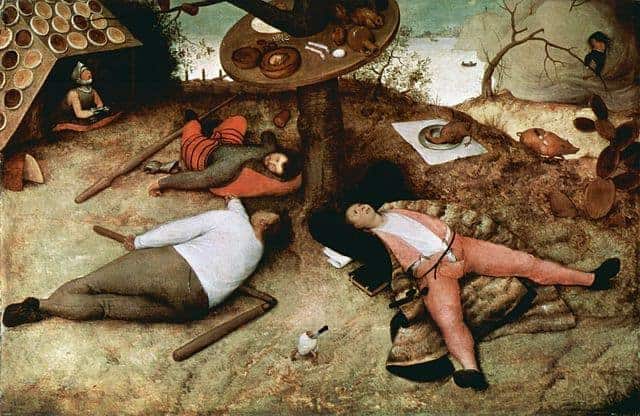The fourteenth century was a dark time in European history. It was a time of war and discord, where the papacy and the French Crown were in bitter dispute. In 1337, the Hundred Year’s War between France and England began. It was also the century of the Black Death, where one in three people died. This disease and discord ripped apart medieval society- and the peasantry bore the brunt. So it is no wonder that people began to dream of a better place, somewhere that was the antithesis of their everyday world. However, this was no Christian heaven, but a more earthly paradise where life was comfortable, food a delight, and the social order turned upside down. Its name was the land of Cockaigne.
In Cockaigne, the harshness of medieval life did not exist. Not only was food plentiful, but it was also the stuff that dreams were made of, where even the houses were built of the ‘little cakes’ that gave this mythical paradise its name. In Cockaigne, there was no backbreaking labor, and the only effort and violence were in the punishment of those who on the top of the social pile in the real world. Cockaigne was a peasant’s Utopia. However, its roots went deeper than the Middle Ages- and it is a concept that continued to survive in one form or another until the present day.

Life in the Land of Cockaigne
“Far out to sea and west of Spain, There is a country named Cockaygne. No place on earth compares to this, for sheer delightfulness and bliss.” So begins one of the earliest accounts of the Land of Cockaigne, a thirteenth-century manuscript thought to have been copied by an Irish Franciscan monk, Friar Michael of Kildare. The Kildare manuscript is now in the British Museum. However, in 1790, a thirteenth-century poem of Cockaigne, of French origin was replicated in “Specimens of Early English Poets” written by George Ellis. It is these poems that are our sources for life in the land of Cockaigne.
In Cockaigne, the trees and flowers were bright in color, and the weather was always mild and pleasant. There were none of the depressing downpours that often blighted real rural life! In this respect, Cockaigne sounded like heaven. However, its other delights were of a much more earthly nature. “There are rivers great and fine, Of oil and milk, honey and wine; Water’s uses there are few—For washing in, and for the view” stated the Kildare version. Ellis’s French poem describes how “the houses were made of barley sugar and cakes, the streets were paved with pastry. ” These buildings could also be savory: “Pies and pasties” filled “rich fillings, fish, and meat.”
Everything in Cockaigne was free, which was just as well as there was no unpleasant employment to earn money for such luxuries. Indeed, there was little need for shops as it seemed ready prepared food was freely available to whoever wanted it. The sky rained cheese and “roasted pigs wander about with knives in their backs to make carving easy, where grilled geese fly directly into one’s mouth, where cooked fish jump out of the water and land at one’s feet.” Eating was not the only carnal appetite that could be readily satisfied. Both poems make it clear that in Cockaigne, sex was freely available- anytime, any place- and with as many partners as you chose.

Cockaigne was a place without want, hardship or rejection. “There are no quarrels and no strife, There is no death, but always life; Food and clothing are never short, You’ll never hear a sharp retort,” promised the Kildare poem. The poem also made it clear it was only a place a peasant could enter. “The man who hopes to share its bliss, For seven years—be sure of this—, Must wade through pigshit to his chin, The pleasures of Cockaygne to win. Gentlemen well bred and kind, May you not leave the world behind, till you take on this enterprise, and serve the penance for the prize. “
This image of Cockaigne was the antithesis of every peasant or serfs life which was why it was so popular. However, Cockaigne did not just deliver otherwise unattainable treats and bar the better off; it was also a place where the social restrictions placed upon the peasantry were thrown off. In Cockaigne, the lower orders castigated their masters with beatings for laxity-not the other way round. It was a fantasy to suit the times- yet Cockaigne’s origins lie in much earlier ages.

